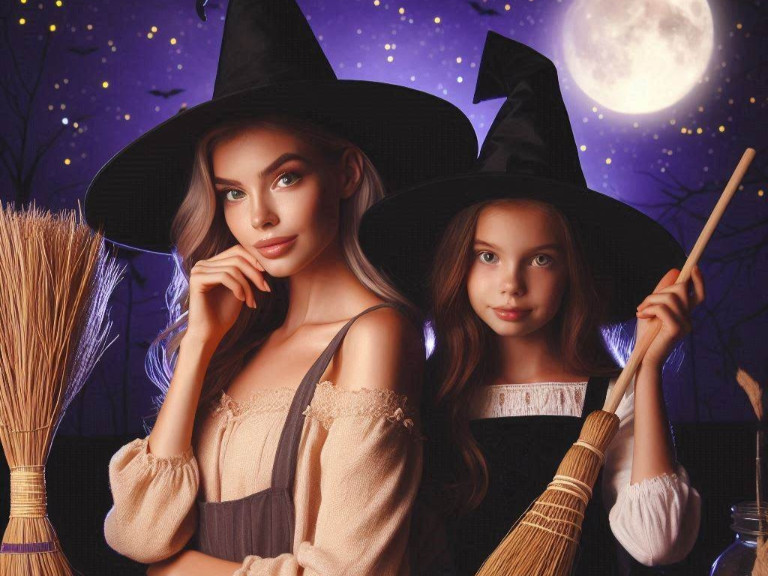
When you picture a typical witch, certain images likely come to mind: a tall pointy hat, flowing robes or a dark cape, a bubbling cauldron, perhaps a black cat or two… and, of course, a broom. From the menacing Wicked Witch of the West with her green face and cackle to the charming Samantha from “Bewitched,” almost every portrayal of a witch includes a broom. But why is this everyday household item so deeply entwined with the image of a witch?
The connection between witches and brooms dates back to ancient times. Perhaps it’s because many early witches were women, and brooms were a common household tool in their daily lives. Or maybe it’s the allure of flight, the thrill of soaring through the night sky, that captures our imagination. Regardless, it’s hard to imagine a Halloween scene without a witch clutching her trusty broom, and iconic stories like Harry Potter would be incomplete without the magical sport of Quidditch, where brooms are essential.
In reality, brooms hold a special place in modern witchcraft as well. Though today’s witch might clean her home with a vacuum, she likely still keeps a broom or two for magical purposes. Traditionally, brooms are used to sweep away negative energy before rituals or as part of Pagan wedding ceremonies, known as handfastings. Yet, their magical uses extend far beyond these rituals.
Brooms can be employed for a variety of magical purposes: cleansing spaces, offering protection, preventing nightmares, attracting love, and even healing. Some legends suggest brooms can bring rain or send away unwanted visitors. This simple tool is far more versatile than it might first appear.
Some witches might keep only two brooms—one for regular cleaning and one for magical work. Others collect many, from small decorative brooms that hang in the kitchen or bedroom to larger, more specialized ones. Witches may personalize their brooms with anointing oils and decorations or even craft their own, selecting materials with care and intention for their specific magical needs.
The broom, with its rich history and wide array of uses, remains a powerful symbol and tool in the world of witchcraft, blending practicality with enchantment in a way that continues to captivate and inspire.
Brooms in History, Tradition, and Lore

The true origins of the broom are shrouded in mystery, likely tracing back to some ingenious early human who discovered a practical way to clean up after a messy day. Since ancient times, people have crafted brooms from bundles of twigs, plant stalks, and other natural fibers to sweep their floors and hearths. While brooms are mentioned in the Bible, they are not linked with witches in those texts.
The earliest brooms, known as besoms, were made from birch twigs tied to handles of hazel or chestnut wood. These rudimentary brooms, bound with strips of willow bark or rope, wore out quickly and often scattered as much debris as they gathered. In Anglo-Saxon England, broom making was a recognized craft practiced by “besom squires,” although most people made their own brooms from available materials, replacing them as needed.
A significant advancement came in the late 1700s when Benjamin Franklin introduced broomcorn to the United States. Despite its name, broomcorn is not related to corn but is an upright grass from the sorghum family. This plant, which can grow up to fifteen feet tall, has stalks ideal for making brooms. Broomcorn is believed to have originated in Africa and then spread to the Mediterranean. According to legend, Franklin found a single broomcorn seed on a whiskbroom given to him by a friend, planted it, and it soon became a garden novelty in Philadelphia.
In 1797, Levi Dickinson, a Massachusetts farmer, began making brooms from his broomcorn crop. He tied round bunches of broomcorn to sticks and wove them into place. His brooms quickly gained popularity, and by 1800, Dickinson and his sons were selling them throughout the Northeast. The Shakers later improved the design by making the broom flat and using wire to secure the broomcorn more firmly, creating a design similar to what we use today.
Despite its adaptability and drought resistance, harvesting broomcorn is labor-intensive. Today, over half of the broomcorn used in mass-market brooms comes from Mexico. However, locally grown and crafted brooms can still be found. In Cooperstown, New York, the Farmers’ Museum demonstrates traditional broom making every summer.
For everyday cleaning, any broom that gets the job done will suffice. However, for magical purposes, a handcrafted broom holds more significance. Creating your own broom from broomcorn or other materials can imbue it with unique power for rituals and spells.
Brooms have long been associated with marriage due to their connection to the hearth and home. The tradition of “jumping the broom” has been part of handfastings and weddings in various cultures for centuries. On the American frontier, where clergy were scarce, jumping the broom could make a marriage official. African American slaves, who were often denied legal marriages, used this practice to solemnize their unions.
Brooms are also widely used in magic for cleansing, purification, and protection. They feature prominently in rituals across different cultures, symbolizing renewal and safeguarding the home. One historical ritual is an Irish threshold rite honoring Brigid at Imbolc. In County Wexford, as late as the nineteenth century, families would gather rushes, bless them, and use them to create protective charms for the home.
This ritual can be adapted for modern times. On Imbolc Eve, one person can gather twigs and branches to craft a simple broom while others prepare a meal inside. The broom is then taken on a sunwise circuit around the house, with a call and response at the door welcoming the blessings of Brigid. After the feast, the broom is dismantled, and Brigid’s crosses are made as symbols of protection and renewal for the coming year.
The humble broom, much like the common rush, served vital roles in pre-modern European homes and inspired rituals focused on cleansing and regeneration. The next time you see a broom, remember its rich history and magical potential. You may never look at one the same way again.
Broom Lore and Superstitions
Given the broom’s ancient history and universal presence in homes, it’s no surprise that it comes with a trove of superstitions, traditions, and sayings. From practical advice to whimsical beliefs, brooms have been the subject of many tales. Here are a few favorites from my collection, with others sprinkled throughout this book for your enjoyment.
General Broom Lore
- To bring rain, stand outside and swing a broom over your head.
- To sweep away nightmares, hang a broom on your bedroom door and place garlic under your pillow.
- Brooms bought in May sweep family away.
- It’s bad luck to bring an old broom into a new house. Always buy a new one and leave the old one behind. (This only applies to regular cleaning brooms, not those used for magical purposes.)
- Lightning is attracted to brooms, so you can use them as lightning rods to protect your home.
- Placing a small broom under your pillow will keep away nightmares.
- It’s unlucky to buy a broom in August.
- Drop a broom, and you’ll get company soon.
- Brooms should be stored bristle-up for longevity and good luck.
- Sweep toward the fireplace, if you have one.
- When moving, it’s bad luck to leave the broom behind, even if it’s old. (Yes, this contradicts the earlier superstition!)
As you can see, brooms are steeped in various superstitions and traditions. These general beliefs often overlap with magical lore, adding another layer of intrigue to this everyday tool.
Magical Broom Lore
The connection between witches and brooms is shrouded in mystery, but several theories offer fascinating insights.
In early Pagan fertility rites, local women would gather in newly planted fields with besoms between their legs, hopping as high as possible to encourage tall crops. This may have given rise to the image of witches flying on broomsticks. Another theory suggests that brooms were used to disguise witches’ wands. Wrapping birch twigs around a carved wand, which often had a phallic design, allowed witches to hide their magical tools in plain sight.
Brooms also symbolized a woman’s power in the home. To signal she was away, a woman might lean her broom outside the door or push the handle up the chimney. This could have evolved into the belief that witches could fly up the chimney on their brooms.
Early Celtic Pagans believed brooms were connected to faeries. A witch would ask a faery to guide her to the perfect tree for her broomstick, and some modern witches carve the faces of Green Men or forest creatures into their broom handles.
Brooms were thought to temporarily house spirits, allowing witches to move unwanted entities to safe locations or call spirits to aid in specific tasks. Unique among magical tools, brooms balance male and female energies: the stick symbolizes the male, and the bristles symbolize the female. This duality is likely why brooms are integral to many handfasting and marriage ceremonies.
The Catholic Church painted a negative picture of witches and their brooms. In 1458, a church inquisitor declared belief in witches’ ability to fly as official doctrine. By 1580, the image of witches flying on broomsticks had solidified. Renaissance demonologists claimed the devil gave witches brooms and flying ointment, allowing them to fly, often with a familiar or demon companion. Male witches, or sorcerers, were said to ride pitchforks.
While much of this lore is fantastical, there is some truth to the idea of flying ointment. This mixture of grease and hallucinogenic plants like belladonna and hemlock was too toxic to ingest, so it was absorbed through the skin. Some stories suggest brooms were used to apply the ointment to sensitive areas for quicker absorption, though this is debatable. The resulting hallucinations gave the sensation of flying or aided in trance journeys or astral travel—definitely not recommended for modern experimentation!
Accusing witches of flying served a practical purpose, explaining how elderly women could travel unseen to distant gatherings. Given that almost every woman had a broom, the accusation was both convenient and believable.
On a more positive note, many goddesses are depicted flying, sometimes on brooms, staffs, or distaffs. This suggests that the image of witches flying might reflect their connection to powerful goddesses. Let’s embrace that interpretation, celebrating the broom as a symbol of magical heritage and divine power.
Broomstick Deities

Many goddesses are associated with brooms, but a few stand out in mythology and folklore for their deep connections to this everyday tool. Here are some of the most prominent broomstick deities.
Baba Yaga
In Russian and Slavic folktales, Baba Yaga is a well-known witch and sometimes seen as a goddess with control over the elements. She wielded a magical broom to sweep away her tracks as she flew through the air in her enchanted mortar and pestle. Baba Yaga is an ancient hag goddess—a mystical crone both feared and revered. Often depicted as a frightening figure with a curved nose, iron teeth, and a taste for children, she could also be a spiritual guide for those brave and clever enough to seek her wisdom.
Baba Yaga was known for her wisdom and power, though she wasn’t always kind. She guarded the doorway to the otherworld and controlled the passage of souls, perhaps even wielding the powers of life and death. As she flew through the air, she was often accompanied by crows, ravens, and owls.
Holda
Holda, a Northern European goddess, was said to lead a pack of hounds and fly at the head of a group of unbaptized children and other dead souls in the Wild Hunt. This eerie entourage, mounted on brooms, flew through the night, especially between Christmas and Epiphany. Holda, also known as Hulda, Snow Queen, and Mother Holle, was primarily a winter goddess. She brought good fortune and prosperity to those with kind hearts and misfortune to the lazy or cruel, somewhat resembling an early female Santa Claus.
As a nature goddess, Holda controlled snow and fog; when she shook out her feather bed, snow would fall to the earth. While some feared her, others, especially those identified as witches, adored her. She traveled during the twelve days between Christmas and Epiphany, bringing gifts of fruitfulness, fertility, and abundance. “Holle-riding” or “Holda-riding” became synonymous with witches’ flight in Germany as late as the nineteenth century.
Sao Ch’ing Niang
Sao Ch’ing Niang, also known as Sao Ch’ing Niang-Niang or Saoquing Niang, is a Chinese goddess known as the Lady of the Broom. Residing on the Broom Star, Sao Chou, she was in charge of weather. Farmers would hang pictures of brooms on their fences to seek her help in bringing rain or driving it away. Sao Ch’ing Niang was considered a mother goddess and one of the nine “dark ladies” of the Chinese pantheon.
For weather magic, tradition says that if you need Saoquing Niang’s help, simply hang a piece of paper with her name written on it near your home. To draw her hope into your life, take a broom and sweep your living space from the outside in toward the center. Symbolically sweeping away “dirt” can improve your outlook. Keep the broom in a special place afterward to represent the goddess.
Each of these goddesses brings a unique perspective to the lore and traditions surrounding brooms. From Baba Yaga’s fearsome wisdom to Holda’s wintery blessings and Sao Ch’ing Niang’s weather control, these deities highlight the broom’s deep cultural and mystical significance.
Your Personal Witch’s Broom

We’d all love to make our own magical tools, but sometimes life gets in the way. Maybe you don’t have the time, tools, or skills. No worries! You can still craft your practice. Just grab a basic item like a candle or a book. Decorate it with things that mean something to you, then bless it to make it special for your magic. The most important part is your intent, not where you got the tool. The universe understands, and your magic will be just as powerful!
Starting with a Premade Broom
Not everyone can find the perfect branch, grow broomcorn, and gather willow bark. That’s okay. Starting with a premade broom and making it your own is perfectly fine.
If you’re fortunate, you might find a local craftsperson who makes brooms traditionally, or you could pick one up at a Pagan or New Age store, fair, or convention. Alternatively, you can order one online from a Witchcraft shop. It’s preferable to get a broom intended for magickal purposes, even if you can’t make it yourself.
While these brooms can be more expensive and harder to find locally, it’s worth it if you can manage. If you prefer not to use an obviously “witchy” broom, or if you’re not out of the broom closet, a standard broom can be just as magickal. Remember, intent is the most crucial element, so starting with a plain broom from the grocery store is perfectly fine.
Buying a Broom
Whether you buy a broom from a specialty store, online, at a craft fair, or from the local hardware store, consider the following:
- Natural Materials: Ensure the broom is made from natural materials. Even if you can’t choose the wood for the handle or the bristle type, avoid plastic or shoddy materials. You want a quality broom for your magickal work.
- Comfort and Energy: The broom should feel good in your hands. Some artistic brooms from Pagan stores might be beautiful but uncomfortable. Hold the broom for a moment—does it feel right? Is there any particular energy in the broom? A neutral energy is fine since you’ll infuse it with your own, but avoid any with unpleasant vibes.
- Decorating Potential: If you plan to decorate the broom, ensure the surfaces are suitable for your chosen decorations. Traditional round besoms can be more challenging to decorate than flat brooms but can look amazing adorned with ribbons and herbs.
- Practical Considerations: Think about how and where you’ll use and store the broom. Is it the right size and shape for hanging above a doorway? Will it match the room’s décor? Decide whether you want a witchy-looking besom or a mundane-looking broom that blends in.
- Soul Connection: Even with a limited budget, find a broom that speaks to your soul. If you can’t afford a large broom, consider a whisk-size broom for a more affordable magickal tool.
Remember, this will be a sacred tool. Find one that suits your practical needs and magickal intentions.
Making Your Own Magickal Broom

Creating a broom is straightforward if you can gather the right materials. Here’s how to make a traditional witch’s besom:
Materials:
- 4-foot length of ash or oak for the handle (adjust length based on height)
- Thin branches of birch or a bunch of broomcorn for the bristles (or woody herbs like mugwort, rosemary, or thyme)
- Lengths of willow, strong twine, or heavy cord for binding
- Scissors or snippers
- A large bucket of warm water
- A large cloth or old sheet (to catch the mess)
Instructions:
- Soak the Bristles: Soak the bristles and willow strips overnight in warm water to make them pliable.
- Arrange the Bristles: Lay the handle on a flat surface and place the bristles next to it, about four inches from the bottom, pointing toward the top of the handle. You’ll flip them later.
- Bind the Bristles: Tie the bristles around the handle with the willow or binding material. Add bristles until the broom is as full as you desire. Tie the binding tightly, adding three, six, or nine knots for an extra magickal touch.
- Flip the Bristles: Fold the bristles over so they point toward the bottom of the handle. Bind them again further down.
- Trim and Finalize: Trim the ends as desired. Visualize your intent and infuse the broom with your energy as you work. Let it dry for a couple of days, then bless and consecrate it.
By following these steps, you can create a magickal broom that suits both your practical needs and spiritual practices.
Your Broom
When making or buying a broom, the first thing to consider is the type of wood used for the handle.
Some people choose a broom simply because it feels right. I once bought a handcrafted broom because I liked how it looked and felt. Like any magical tool, you might be drawn to the right broom instinctively. If you find a broom that makes your heart happy, you’ve probably found the one for you.
However, if you seek specific magical qualities, you’ll want to choose a wood with those associations. Remember, magical associations can vary and what’s right for one person might not work for another. Trust your intuition.
Finding the Right Wood
You can find broom wood in various ways. If you live on a property with trees, you might find a broom handle right outside your door. You can use a piece of fallen wood or cut a branch from a living tree. If you do the latter, remember to show gratitude to the tree.
Taking wood from a living tree isn’t always harmful. For example, apple trees need pruning to stay healthy, and pruned branches can be used for brooms or wands. However, large-scale pruning should be done with care or by a professional to avoid harming the tree.
If you don’t have trees on your property, try nearby woods or parks for fallen limbs. Ensure it’s legal to remove wood from the area. You can also ask friends with wooded property for permission to collect wood.
City dwellers might need to buy wood for a broom handle or a ready-made broom. Look for one made from your preferred wood.
Common Woods and Their Magical Associations
- Alder: Associated with water, protection, and women’s cycles. Symbolizes endurance, strength, and passion.
- Apple: Associated with love, healing, and immortality. Symbolizes beauty, love, and generosity.
- Ash: Traditional choice for witch’s brooms. Associated with protection, strength, healing, and prosperity. Symbolizes connection, wisdom, and surrender.
- Birch: Feminine, associated with birth and new beginnings. Symbolizes purity, healing, and light.
- Elder: Known as the witch tree, associated with protection, love, and purification. Symbolizes transition, evolution, and continuation.
- Elm: Linked to witches, used for love magic. Symbolizes protection, expression, and connection.
- Maple: Associated with prosperity, love, and long life.
- Oak: Traditional and masculine, associated with power, protection, and luck. Symbolizes strength, stability, and nobility.
- Pine: Common in store-bought brooms, associated with healing, fertility, and prosperity. Symbolizes clarity, achievement, and energy.
- Rowan: Spiritually protective, used for protection and connection. Symbolizes protection, expression, and connection.
- Walnut: Associated with love, prosperity, healing, and luck.
Feel free to use wood native to your region or whatever feels right to you. Broomsticks can be clean and smooth or retain their natural bark for character, and they can be carved or decorated.
Broom Bristles
Once you have the stick for your broom, choose the material for the sweeping end. Traditionally, birch twigs were used, but broomcorn is now more common for its effectiveness. Plastic brooms don’t work as well and aren’t suitable for magical work.
- Broomcorn: Easy to work with and widely available. It has natural energy and can be grown if you have space. Broomcorn is also used for wreaths and decorative projects.
- Birch Twigs: Traditional for magical brooms (besoms). Used in purification rituals, protection, and exorcism. Besoms made with birch twigs have the traditional round, irregular shape.
- Willow Twigs: Known for their flexibility and resilience, willow twigs are excellent for making brooms that are used for divination and dream work. Willow is associated with the moon, water, and feminine energy, making it ideal for rituals involving intuition and emotions.
- Hazel Twigs: Often used in dowsing rods, hazel is a tree of wisdom and protection. Brooms made with hazel twigs are perfect for spells and rituals involving knowledge, wisdom, and protection.
- Pine Needles: Pine is associated with healing, fertility, and prosperity. Brooms made with pine needles are not only aromatic but also great for cleansing and purification rituals.
- Oak Twigs: Oak is a powerful tree associated with strength, stability, and protection. Using oak twigs in your broom will imbue it with these qualities, making it perfect for protection and power rituals.
- Heather: Heather has a long history in magical traditions, symbolizing passion and luck. Brooms made with heather are often used in rituals to enhance love and luck.
- Lavender Stalks: Lavender is known for its calming and purifying properties. A broom made with lavender stalks can be used to cleanse spaces of negative energy and to bring peace and tranquility.
- Rosemary Sprigs: Rosemary is a potent herb for protection and purification. Brooms made with rosemary sprigs are excellent for banishing negativity and protecting your space.
- Sage: Sage is widely known for its purifying and cleansing properties. Brooms with sage bristles are ideal for rituals to remove negative energies and to bless and consecrate spaces.
- Thyme: Thyme is associated with courage and health. Using thyme in your broom can add properties of protection, health, and bravery to your rituals.
- Yew Twigs: Yew is a tree of transformation and rebirth, making it perfect for brooms used in rituals involving endings, new beginnings, and ancestor work.
Choose what feels right to you, and remember that a broom’s magic comes from both its materials and your intent.
Anointing Oil and Herbs
Just like any other magical tool, your broom can be blessed and consecrated through a simple ritual. I typically use salt, water, incense or sage, and candles to represent earth, water, air, and fire, along with a candle for the goddess and god. Sprinkle the broom with salt and water, waft the incense or sage smoke over it, and hold it carefully over the candle flame. Then, ask the god and goddess to bless the tool and the magical work you’ll do with it. Easy peasy! Make sure to perform this ritual in a sacred space with intent and focus. For detailed instructions, refer to the beginning of chapter 8.
For an extra boost, you can use anointing oil or specific essential oils and herbs to imbue your broom with a particular purpose. For instance, if I’m using a candle for success magic, I’ll anoint it with an oil containing peppermint or basil, both known for their prosperity-enhancing properties.
I used to make and sell magical oils at shows and a friend’s store, and I still have a shelf full of tiny bottles of prosperity oil, healing oil, love oil, and more. They’re handy to have around, and you might want to consider making some of your own. If you don’t want to invest in many bottles of essential oils, you can buy some excellent pre-made magical oils from reputable shops and online sources.
Alternatively, you can buy a few individual essential oils, bless and consecrate them for magical work, and use them singly instead of in combination. Always use quality essential oils, not fragrance oils, which are artificial and lack the power of the plant’s essence. It’s better to have a small bottle of a high-quality oil like rose or chamomile and use it sparingly than a large bottle of something less effective. My favorite essential oils come from Nature’s Alchemy, which offers great quality at reasonable prices.
Here are some of my favorite combinations for magical anointing oils, which work on tools, candles, or even in a soothing bath. You can also use any individual oil listed. Remember, different witches have different preferences, and many herbs can add power to magical items. Don’t ingest essential oils unless they’re labeled as safe for consumption.
- Energy, Strength, and Courage: cinnamon, ginger, lemon, orange
- Healing: calendula, lavender, lemon balm, rosemary
- Love: geranium, lavender, lemon, rose
- Peace and Happiness: bergamot, chamomile, geranium, lavender, lemon balm
- Prosperity: basil, bergamot, cinnamon, peppermint
- Protection and Purification: geranium, lemon, rosemary
- Psychic Ability and Conscious Mind: chamomile, ginger, lavender, peppermint
If you don’t have these herbs in essential oil form, you can use them fresh or dried. I use a small list of oils in different combinations to keep things simple and affordable. Some oils, like rose, are very expensive, so I use only a drop or two and more of less pricey oils.
Start with one drop of each oil and adjust as needed. Aim for a pleasant scent as well as magical power. My rule of thumb is to use nine drops in total, as nine is a powerful magical number. Use any base oil you like; I often use olive oil, but it goes rancid faster than jojoba. Sesame oil is also a good option and easy to find.
For a broomstick anointing oil, you might want to melt a little beeswax and add the anointing oil. Smooth this mixture on the broomstick handle before first use or anytime it needs an energetic boost. Doing this under the full moon is especially potent.
Ultimately, use the oils or herbs that feel right to you. There’s no wrong choice or combination as long as you trust your inner wisdom.
Useful Tips for Caring for Your Magickal Broom
Here are some practical tips to keep your magickal broom in top condition:
- Personal Use Only: Treat your broom as a personal magickal tool—never lend it to others. However, if you practice with a group or coven, it’s perfectly fine for communal use. In fact, creating a joint “coven broom” can be a meaningful group activity. My group, Blue Moon Circle, crafted a group staff years ago that we still cherish and use.
- Dedicated Use: Avoid using your magickal broom for mundane sweeping tasks. Magickal tools should be reserved for magickal purposes only. Some people prefer to have different brooms for various magickal intents, such as protection or spiritual cleansing. While this isn’t strictly necessary, it can be beneficial if your brooms serve distinctly different functions. The only exception to this rule is if you have a broom specifically dedicated to magickal cleansing or spring cleaning. In such cases, using it for actual cleaning is appropriate, but only with magickal intent.
- Proper Storage: Store your broom with the handle down and the bristles up. This traditional method helps prolong the life of your broom. Alternatively, you can hang it on the wall or over a doorway.
- Energy Sweeping: When using your magickal broom to cleanse a space (such as before a ritual), the bristles don’t need to touch the ground. You’re moving energy, not dust. Some practitioners prefer to hold the broom upright and sweep through the air, while others, like myself, keep it a few inches off the ground or at knee level.
- Respect and Care: Treat your broom with the same care and appreciation as any other magickal tool. If you feel it has served its purpose and needs to be retired, do so respectfully. You can burn or bury it, or if necessary, disassemble it and unconsecrate it before disposing of it. Always thank it for its service.
- Moving with Your Broom: The old rule about never bringing an old broom into a new house doesn’t apply to magickal brooms. They are welcome to move with you wherever you go!
By following these tips, you can ensure that your magickal broom remains a powerful and effective tool in your spiritual practice.
Unique Specialty Brooms: Elevate Your Craft

Practical Brooms
For a witch, a broom is more than just a tool for mundane cleaning—it’s a conduit for magickal cleansing and renewal. Consider infusing your everyday broom with magickal properties to transform household chores into spiritual acts. Crafting a magickal cleansing wash with essential oils like lemon, lavender, or peppermint, along with purifying herbs, can imbue your broom with potent energy. As you sweep, visualize negative energies dissipating, leaving behind a refreshed and harmonious space.
Alternatively, designate a broom specifically for seasonal or ritual cleansing. Crafted with intention, this broom becomes a sacred tool for clearing away stagnant energy during times of transition or upheaval, infusing your home with renewed vitality.
Ceremonial Brooms
A ceremonial broom serves as the quintessential ritual tool, ideal for cleansing sacred spaces and setting the stage for magickal workings. Whether adorned with intricate carvings, runes, or symbolic charms, your ceremonial broom becomes a potent instrument for channeling energy and intention during ceremonies and rites. Dedicate it with blessings and consecrations, ensuring its sanctity as a cherished magickal tool.
Decorative Brooms
Brooms aren’t just for practical use—they can also serve as enchanting decorative accents in your sacred space. Infuse your home with magickal vibes by adorning brooms with pentacles, runes, or other mystical symbols. Whether opting for subtle touches or bold statements, decorative brooms add a touch of witchy charm to any room. Get creative with materials, from dried herbs and flowers to colorful ribbons and beads, to craft a broom that reflects your unique style and spirituality.
Embrace the versatility of specialty brooms, transforming mundane chores into magickal acts and infusing your living space with enchantment and intention.
Broomstick for the Young Witch

Raising children as Pagans in a non-Pagan world can be challenging, but many parents I know have done it beautifully. Their kids grow up to be wonderful adults, deeply connected to nature and spirituality. One such example is my coven-cousin Sarah, who is teaching her children to appreciate nature, commune with the spirits of the earth, and honor the cycles of the moon.
Introducing children to Witchcraft can be a magical experience, especially when you engage their creativity. Kids love being involved in the “craft” part of the Craft, and making their own brooms is a perfect way to blend fun with learning.
Here’s a guide to help your young witch create their very own broomstick.
Getting Started
Start by discussing the broom’s history and lore. For young children, find a fun book featuring a flying witch and talk about the difference between fictional witches and real ones.
Next, gather your supplies. Depending on the child’s age, you might use a whiskbroom or a downsized besom more suitable for their height. You can make the broom together inside a sacred circle, at the kitchen table, or even outside if the weather is nice. If you regularly practice magical rituals with your child, bless and consecrate the broom together. Otherwise, simply hang the broom in the child’s room or a special place in your home.
Decorating the Broom
Use your imagination to decorate the broom. Tailor it to the child’s interests. A “girly girl” might want a pink, glittery broom, while a budding astronomer might prefer one with stars and moons. You can use items from around the house or collect natural objects like shells and pine cones together.
The most important ingredient is fun!
Crafting a Magical Moon and Stars Broom
What You’ll Need:
- A broom: You can make one yourself or buy a premade one. It can be a whiskbroom or a handmade besom. If possible, get a broom with a thong at the top for hanging, or tie a piece of leather or wire around the top.
- Ribbons: Choose five or six different colors. Let the child pick their own. Each ribbon should be long enough to hang most of the way down the broom’s bristles.
- Colored construction paper: Choose colors that coordinate with your ribbons.
- Shiny paper in gold and silver foil
- Scissors: Child-safe or help with cutting as needed.
- White glue
- Glitter: Optional, but glitter glue can be less messy.
- Star and moon stickers: Optional, for extra decoration.
- Star and moon stencils: Optional if you prefer not to draw freehand.
- Natural items: Dried herbs, flowers, acorns, small pinecones, shells, pretty rocks, dried leaves, feathers, seedpods, or any other items you find together.
- String or wire: To attach larger items.
- Small pentacle: Ceramic, metal, or glass, to hang from the broom (optional).
- Cloth: To catch the mess.
Assembling the Broom:
- Lay out the cloth to catch any mess.
- Arrange all your supplies.
- Lay the broom flat and let your child decorate it. Give as much help as needed, but allow them to take the lead.
Encourage your child to use their creativity and intuition. This is their first broom, and it should be a reflection of their personality and magical energy. Enjoy the process and celebrate the creation together with some star- and moon-shaped cookies!
Simple Broom Spells

The humble broom, often overlooked, holds a revered spot in magickal traditions, channeling energies to bring about desired changes. From ancient rituals to modern adaptations, these spells harness the power of the broom to bring growth, communication, protection, and cleansing into our lives. Here are a few simple broom spells that can easily be incorporated into your everyday magickal practices.
A Spell to Summon Rain
Weather magick should be used thoughtfully, considering its broader implications. If your garden desperately needs rain, you can call upon this ancient practice. Begin with a clear intention to cause no harm.
Take your magickal broom outside and swing it clockwise around your head while chanting:
Rain clouds gather, hear my call,
Let gentle showers begin to fall.
Quench the earth, let life renew,
With this broom, I summon you.
“Make My Garden Grow” Spell
In ancient Pagan traditions, brooms were taken to the fields, and practitioners would hop around, riding the broom and believing that their jumps would dictate the height of their crops. While you might prefer a more discreet approach today, a modern adaptation of this fertility ritual can still help your garden flourish.
Take your magickal broom and sprinkle it with rainwater collected in a bucket. Whether you choose to walk, run, or dance around your garden, flick the rainwater from the broom’s bristles as you chant:
Rise and thrive, reach for the sky,
Grow with strength, as days go by.
Bloom and flourish, tall and bright,
Grow, my garden, with all your might!
Spell to Speak to the Dead
Broom lore suggests that placing a broom across your doorway can open channels to communicate with ancestors or lost loved ones. Approach this with care and ensure you cast protective magick before attempting to contact the deceased.
If you feel a presence trying to reach out, lay your magickal broom across any doorway in your home and say:
Spirits of old, hear my plea,
In peace and love, come talk to me.
As broom lies here, the path is clear,
Speak now, I listen, without fear.
To Banish Nightmares
For a quick remedy to banish bad dreams, hang a broom over your bed and recite this simple charm before sleep:
Sweep away troubles, sweep away dread,
Keep bad dreams from my head.
Guard my rest through the night,
Bring peaceful dreams till morning light.
To Bless a New Household Broom
To imbue your everyday broom with magickal power, inscribe it with intentions. Use a permanent marker or a wood-burning tool to write on one side, from the bristles to the handle: “I sweep in abundance and joy.” On the opposite side, write from the handle to the bristles: “I sweep out negativity and strife.”
To Sweep in Love
To invite love into your life, open your front door and sweep inward while saying:
With each sweep, love draw near,
Bring joy and warmth to all who are here.
Love in all its forms, I welcome thee,
Fill this space with harmony.
A Simple Cleansing Spell
For a quick energy cleanse in your home, sweep from room to room, visualizing negative energy being swept out. End at the front door, sweep the energy outside, and say:
With this broom, I cleanse each room,
Banishing darkness, lifting gloom.
Positive energy, fill this place,
With love and light, I seal this space. So mote it be.
Shake off any remaining negativity from the broom and firmly close the door behind you. These simple broom spells integrate magick into your daily life, transforming a mundane tool into a powerful conduit for positive change and energy.
Unique Broomstick Gift Ideas

For the Garden Witch
What better way to enchant a fellow witch than with a personalized broom tailored to their green thumb? For the garden witch in your life, consider crafting a broom adorned with a medley of delightful and practical treasures. Packets of seeds with magickal properties (hint: many herbs serve both magickal and culinary purposes), gardening gloves, and miniature tools like tiny hoes and bulb planters can all find a home on this bewitched broom.
Additionally, you can incorporate snippets of gardening wisdom, perhaps from cherished books like Dorothy Morrison’s “Bud, Blossom & Leaf” or Ellen Dugan’s works like “Garden Witchery” and “Cottage Witchery,” into decorative scrolls or colorful notes.
For the Kitchen Witch
Elevate the culinary craft of a kitchen witch with a broomstick gift that blends style with utility. Deck out a broom with strings of cooking herbs—especially those with magickal attributes—and suspend them gracefully. Complement this with an array of practical tools like measuring cups, spoons, and a petite mortar and pestle. For added flair, include handwritten recipes from beloved witchy cookbooks or copied excerpts on fancy paper.
Peruse through culinary enchantments within books such as “The Wicca Cookbook” by Jamie Wood and Tara Seefeldt, “Witch in the Kitchen” by Cat Johnson, or “Cucina Aurora” by Dawn M. Hunt for delectable inspiration.
A Going-Away Broom
When bidding adieu to a witchy friend embarking on a new journey, gift them a broom adorned with cherished memories intertwined with hopes for the future. Select a broom that resonates with their taste and embellish it with shared moments captured in photographs. Collaborate with friends to infuse the broom with collective mementos and keepsakes from past adventures, whether it’s seashells from beach strolls or tokens from shared hobbies.
Include a heartfelt note, or perhaps several from a group of friends, to serve as a comforting reminder of the bonds shared, to be unwrapped during moments of homesickness.
A Get-Well-Soon Broom
When a loved one is ailing, express your well wishes with a thoughtful twist by presenting them with a healing broomstick. Decorate the broom with items aimed at soothing and restoring health—garlic cloves for homemade soups, healing herbs, calming tea bags, and bath sachets infused with aromatic blends. Tuck in a spell for wellness alongside small entertainments like crossword puzzles, miniature books, or cheerful jokes to uplift their spirits.
Accompany your gesture with a heartfelt note, and envision them using the broom to sweep away the remnants of illness, ushering in a brighter, healthier tomorrow.
Final Musings
As we wrap up our exploration of the witch’s broom, it’s clear that this humble tool is much more than it seems. Steeped in rich history and folklore, the witch’s broom holds a special place in the hearts of many who practice witchcraft. It’s a symbol of cleansing, protection, and a tangible connection to nature and magic.
Creating your own witch’s broom can be a deeply personal and rewarding experience. Each step, from selecting the right twigs and herbs to binding them together, allows you to infuse your intentions and energy into a tool that will serve you well. Whether you’re sweeping away negativity or simply enjoying the beauty of your handmade creation, your broom becomes a reminder of the magic that exists in everyday life. Here’s to finding joy in the craft and the simple, powerful magic of the witch’s broom.





2 Comments
I’ve searched the internet and found no information on a question I have. I am hoping you can answer this for me. Tonight, a witch told me that when you purchase a new broom that in order to “bond” with it, you need to unbind it. I’ve never heard of this before. Is this true?
Hey Sabine!
When you get a new broomstick, it’s a good idea to cleanse away any lingering energy and give it a fresh start. Just hold it under running water for about 30 seconds to wash off the old vibes. After that, you can either hold it in your hands and focus on charging it with your own energy, or let it sit by a window where the moonlight can work its magic. Both ways will get it ready to align with you and your space. Blessed be.